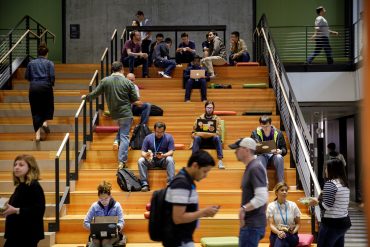
Amazon Plans AI-Driven Cuts to Corporate Workforce, CEO Says
6 minute read

Amazon’s AI workforce overhaul sparks industry-wide shift as tech giants invest billions in automation capabilities
Three Key Facts
- Amazon CEO announces workforce reduction due to generative AI adoption, affecting the company’s 1.56 million global employees as AI tools reduce need for traditional roles.
- Tech giants spending $80 billion on AI infrastructure with Microsoft leading fiscal 2025 investments in AI-enabled data centers while reallocating resources from traditional engineering and sales positions.
- AI now writes 30% of code at major tech firms including Meta and Microsoft, with predictions reaching 95% automation by 2030, fundamentally reshaping software development workflows.
Introduction
Tech giants are aggressively restructuring their workforces as they double down on artificial intelligence investments, with Amazon leading the charge in workforce transformation. Amazon CEO Andy Jassy recently informed employees that the company’s corporate workforce will be substantially reduced in coming years as it adopts generative AI tools and AI agents across operations.
The move represents a broader industry trend affecting major players including Microsoft, Alphabet, and Meta. These companies are reallocating resources from traditional roles, particularly in engineering and sales, to fund massive infrastructure and research spending for AI capabilities.
Key Developments
Jassy described generative AI as “a once-in-a-lifetime technology” that will transform company operations in an internal memo to employees. He emphasized the need for efficiency and adaptability while encouraging workers to embrace AI tools in their current roles.
“We will need fewer people doing some of the jobs that are being done today, and more people doing other types of jobs,” Jassy wrote. “In the next few years, we expect that this will reduce our total corporate workforce as we get efficiency gains from using AI extensively across the company.”
Amazon has already laid off more than 27,000 employees since 2022, including recent cuts to its devices and services units. The company is deploying generative AI across virtually every business unit, from Alexa personal assistant features to shopping tools, advertising platforms, and fulfillment network optimization.
Market Impact
Amazon’s announcement affects its position as the second-largest private employer in the United States. The company currently operates “over 1,000 Generative AI services and applications in progress or built,” though Jassy noted this represents just a fraction of planned development.
Microsoft plans to spend $80 billion on AI-related infrastructure in fiscal 2025, focusing on AI-enabled data centers for model training and cloud deployment. This massive capital allocation demonstrates the scale of investment required for AI transformation across major technology companies.
The workforce reductions come as AI tools demonstrate measurable productivity gains. At major tech firms like Meta and Microsoft, AI now writes up to 30 percent of code in development projects, with Microsoft CTO Kevin Scott predicting that figure could reach 95 percent by 2030.
Strategic Insights
The restructuring highlights AI’s double-edged impact on technology employment. While AI promises efficiency gains and new product opportunities, it threatens established job categories and reshapes traditional software development workflows.
Technical roles face the most immediate impact, particularly software engineers and product managers whose functions are increasingly automated. Customer-facing positions remain less affected currently, but the trend suggests broader workforce transformation across technology companies.
Amazon’s approach of implementing buyouts and layoffs to free capital for AI initiatives signals a fundamental shift in resource allocation priorities. Companies are choosing to reduce human capital costs to fund technological infrastructure investments.
Expert Opinions and Data
Workplace experts view Jassy’s transparent communication as potentially influential across the industry. Marlo Lyons, certified executive coach and author, told Business Insider that Amazon’s directness might encourage other companies to adopt similar messaging.
“I think if you have a big company that’s talking about AI, then it does make it easier for smaller companies to talk about AI — this is basically culture modeling,” Lyons explained.
Dario Amodei, CEO of Anthropic, warned that AI could eliminate up to half of all entry-level white-collar jobs within one to five years, potentially driving unemployment to 10-20 percent. His assessment reflects growing concerns about AI’s broader economic impact beyond technology companies.
Thomas Roulet, professor of organizational sociology and leadership at the University of Cambridge, noted that linking layoffs with AI was not new, even if Jassy’s openness represented a turning point. “The reality is that bringing in AI into work takes a lot of learning cycles and trial and error — it does not appear clearly overnight,” he emphasized.
Conclusion
Amazon’s workforce transformation announcement reflects the technology industry’s broader shift toward AI-driven operations and reduced reliance on traditional employment models. The company’s direct communication about job displacement sets a precedent for how major employers address AI’s impact on their workforce.
These developments underscore the human cost of technological progress while raising fundamental questions about reskilling programs, social safety nets, and the future structure of work in technology-dependent industries. The ongoing restructuring serves as a critical indicator of how AI adoption will reshape employment across major corporations.





